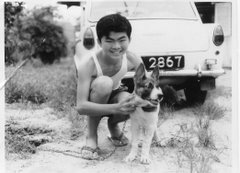I took up squash during the tail-end of my OCS days in Safti. My section mate, Lim Kheng Guan taught me how to play the game. Subsequently when I was posted to 30 SCE in Mandai, I had more time to play the game. We did not have our own courts and had to go next door to use the one at 40 SAR. At that time, the SAF had plans to build at least two squash courts in every camp.
Elsewhere in Singapore, it was still very difficult to find a squash court, and so after my ROD, I often had to depend on my friend KG, who was a regular, to bring me to his camp at Selarang Barracks to play. He was the QM (quartermaster) in one of the SARs (Spore Armoured Regiment). He also brought me to SCSC (SAF Command and Staff College) at South Buona Vista occasionally.
 Mar 1978 (obviously posed) photo taken at Gillman Camp. Notice the wooden racket. My first racket was a Dunlop, a popular brand at that time. Another popular brand was Ascot.
Mar 1978 (obviously posed) photo taken at Gillman Camp. Notice the wooden racket. My first racket was a Dunlop, a popular brand at that time. Another popular brand was Ascot.The design of the new squash courts in SAF was terrible. To access the viewing gallery, you had to climb a ladder – I repeat, ladder, not staircase. Thus whenever we brought lady friends along, it was quite inconvenient.
When I started work in Philips (Audio Factory) in Toa Payoh, I was a member of the Sports and Recreation Club Committee. As squash convener, it was my duty to book the squash courts for our players. I usually went to the SSC (Singapore Sports Council) office in Kampong Java Road early on Thursday morning to book the courts there so that my colleagues and I could play on Saturday morning. There were two sets of squash courts in Kampong Java. One was near the KFC restaurant (A) along Kampong Java Road where the KK Hospital sits today. The other (B) was next to New Cemetery Road (later renamed Cavenagh Road) where there were many tennis courts. The design of the courts near KFC was even worse than those in the SAF.To get into the court, you literally had to stoop and crawl through a tiny door!
 Today, the squash and tennis courts at B would be sitting smack on the entrance to the CTE Tunnel.
Today, the squash and tennis courts at B would be sitting smack on the entrance to the CTE Tunnel.Occasionally, I managed to get another former army mate who was working at the HDB (Housing and Development Board) to book a court for us at the HDB Club. Do you know where that was? It was located at Toa Payoh Lorong 6; near to the stadium. I am not sure …. I think it was subsequently turned into the present Safra Club.
Later on, I managed to secure a long term booking for a court at Anglo-Chinese Junior College. I remember on one occasion running into my former Add Maths teacher Mr Chee Keng Lim who had become the principal of ACJC. I often trained with my Philips colleagues – not just those from my factory, but also friends from other Philips factories, including those in Jurong. Once a year, we represented Philips in the Seira (Singapore Electronics Industries Recreation Association) inter-factory competition, playing against other MNC’s like HP, TI and National Semiconductors. Unfortunately, they only allowed one place in the team for the ladies because we had not 1 but 3 very strong lady players; and we never did very well in the competition. The Seira competition was usually held at the courts in Fort Canning or the East Coast Recreation Centre – next to the MacDonald’s restaurant.
As I said, getting a squash court was very difficult in those days. And so if we knew any friends who had the ‘lobang’ we would ask them to bring us along. Thus I remember playing in places like the Shell Club in Pulau Bukum and Paya Lebar Road and others. One other place where I went to regularly was on the roof top of the PUB Building at Sommerset Road. My old friend Heng Tew used to work there and he would sign us in on Saturday mornings. We would also make use of the swimming pool there.
In 1986, when my new employers, NPB (National Productivity Board) moved to its own building in Bukit Merah Central, we finally had our own squash courts. I remember playing with one very famous ‘colleague’; our chairman Mr Mah Bow Tan, who was the minister-of-state for Trade and Industry at that time. In fact yours truly was the winner of the inaugural Mah Bow Tan challenge trophy.
In the late 80’s, squash courts became widely available in the numerous condominiums and country clubs which had sprung up in Singapore. At the same time, the popularity of the sport waned. I often wonder; maybe Singapore would still be a top squash nation if we didn’t build so many condominiums. Maybe it is human nature that when good things are in abundance, they lose their attractiveness.



















